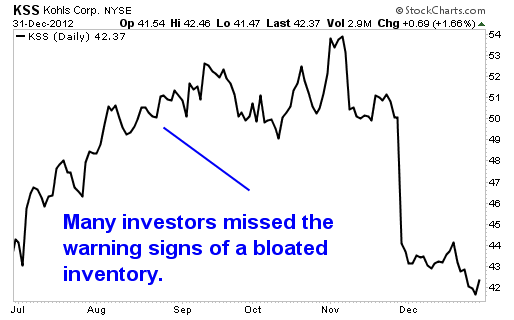If you regularly shop at department store chain Kohl's (NYSE: KSS), you may have spotted an unusual merchandising misstep in the spring of 2012.
The retailer, which had built a longstanding reputation for solid designs, good quality and reasonable prices, started to carry less appealing merchandise that spring. Many shoppers browsed but went home empty-handed.
Just a few months later, you would have seen this problem appear on Kohl's financial statements. In the second quarter of fiscal 2012 (ended July 30, 2012), Kohl's unsold inventory of goods stood at $3.5 billion, or 83% of that company's quarterly sales base. Just a year earlier, that percentage stood at 73%.
Investors willing to take the time to track this retailer's inventory levels (as a percentage of sales) were the first ones to realize that Kohl's was in trouble. By the time the next quarter's results came out, this balance sheet ratio had swelled to a company record 107%. (What that means is that the company had more inventory than an entire quarter's worth of sales)
When Kohl's owned up to its merchandising problem later that fall, the rest of the investment community followed the lead of these balance sheet watchers and aggressively dumped the stock.

Here are three other important balance sheet metrics you need to watch, so you can get out before the rest of the crowd.
1. Provision For Doubtful Accounts
After shipping a product to a customer, a company will often allow for payment terms of 30, 60 or even 90 days. Yet when the due date arrives and the payment doesn't show up, the company will grow understandably nervous. The company's chief financial officer will place that invoice into a balance sheet category known as 'provision for doubtful accounts.'
As an investor, you want to see how this balance sheet item grows or shrinks every quarter. A rising figure means that one large customer (or several smaller customers) has run into trouble, which means those payments may never get collected, and the customer is less likely to place orders in the future.
This is also a very important item to track amongst banking stocks and credit card issuers. If consumers become delinquent on their loans or credit card payments, then the bank may eventually have to write them off as a loss. Indeed 'rising loan-loss reserves' was an early sign of trouble in the U.S. banking industry in late 2007 and early 2008, before events exploded into a full-blown economic crisis.
2. Underfunded Pensions
Over the past few years, investors have marveled at the stunning levels of cash now held by leading automakers. GM (NYSE: GM), for example, had $34 billion in cash and investments on its books at the end of 2012. Some investors may have mistakenly assumed that such a huge amount of money meant GM could issue huge dividends and stock buybacks while also sharply boosting its spending on new products.
Here's what these investors might not have noticed: Buried further down on the balance sheet, it was clear that GM faced a $37.6 billion gap between the money in its pension plan and the money it will owe its retirees. That's why companies like GM, with underfunded pensions, can't afford to lose money. They need every penny they have to meet pension obligations, and they would go broke if their rapidly aging workforce started to require ever-larger pension outlays.
If you own shares of a longstanding industrial firm that had a pension plan over many decades, then you need to know the funding status of their pensions.
3. Too Much Goodwill
When a company acquires a rival, it often pays more than the target's shareholder equity (or book value). If so, the difference needs to be accounted for as 'goodwill' on the balance sheet. Cisco Systems (Nasdaq: CSCO), for example, has paid out billions of dollars for many small companies that were little more than a concept and an engineering team, and as a result, now carries $17 billion in goodwill.
Cisco's management believes that these deals will generate solid returns, more than compensating for their lofty purchase prices. But what happens if the acquired companies fail to deliver what had been expected? Cisco would have no choice but to write down goodwill to reflect the failed acquisition.
That's why it's crucial to track goodwill at such companies. If they are spending lots of money on acquisitions but failing to profit from them, then it's a clear sign that management is unable to deliver the long-term growth rates that will keep investors happy.
The Investing Answer: Most investors focus on the income statement to identify potential upside for a stock. Yet it's the balance sheet where you will find early signs of possible share price downside. That's why you should be spending at least as much time on this often-overlooked financial statement.



